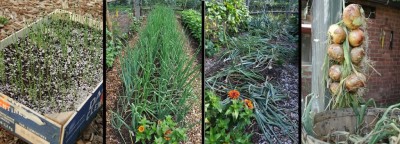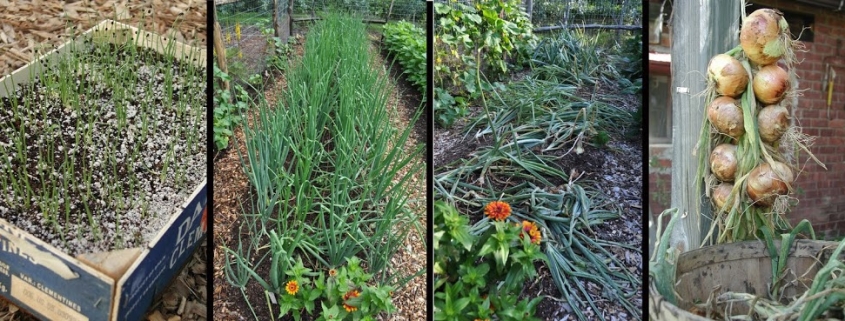[act, onions]
At last week’s Northeast Permaculture Convergence, I gave a lecture and had the opportunity to attend a lecture, the latter by the diva of dirt, or, at least, of compost tea, specifically aerated compost tea (ACT), Dr. Elaine Ingham. You’ve never heard of ACT!? It’s been the hot, new thing for the past few years, an alleged cure for poor soil and plant diseases. I’ve been skeptical and thought that hearing and speaking to Dr. Ingham in person could entice me into the fold.
Dr. Ingham showed myriad images of fungi, nematodes, and other creatures that you might find in compost piles and teas. We saw many “bad guys” that lurk in poorly aerated composts and teas. The “bad guys” are bad, she asserted, because they release toxins into the soil and puff away as gas valuable nitrogen, sulfur, and phosphorus as, respectively, ammonia (not true, the release would be as nitrogen oxides), hydrogen sulfide, and phosphene (except that most phosphorus from phosphene is re-incorporated into the soil before it even gets away).
Dr. Ingham suggested monitoring our compost pile and tea happenings by purchasing a microscope and, with the help of her workshops, identifying resident microorganisms. Hmmm; interesting, but is it really necessary for a green thumb?
While the panoply of microorganisms discussed was impressive, I contended and contend that even a well-aerated compost pile or tea is bound to have some poorly aerated pockets. It’s not a “bad guys” vs. “good guys” situation, but a question of generally favoring an excess of “good guys.” Also, once compost is spread on the ground, the large surface area presented is going to tip the balance even more in favor of aerobic conditions.
(The photo shows me brewing up some compost tea, which I once tried on a few different plants. Response of plants was nothing, nada, zip, rien.)
More fundamentally, I still question the basic assumptions underlying the use of compost tea. Even if you have beneficial organisms in hand (figuratively) and sprinkle them on the ground, they are bound to expire unless the environment is suitable, in which case they will generally be present anyway. Bulky organic materials, such as compost, manure, leaves, and straw, are what nurture these microorganisms.
Spraying ACT on plant leaves should have little or no effect on plant diseases; again, conditions there are not conducive to their survival. In the evolutionary scheme of things, why would a microorganism that thrives in the dark, moist, nutrient-rich innards of a compost pile survive on the sunny, dry, nutrient-poor surface of a plant leaf, let alone provide any benefits. Independent university studies do not generally support the claims made for compost tea. Good gardening comes form using a pitchfork, not an elixir.
————————————————————–
Onion leaves have yellowed and, on most of the plants, flopped down. That’s a good thing. Onions so elegantly demonstrate their life cycle, waxing and waning in response to the progress of the seasons.
At the base of the leaves, the bulbs have swollen into 4 inch diameter, glossy, white orbs. These orbs trace their beginnings back to early February, when I sowed seeds in flats of potting soil. The three varieties, New York Early, Varsity, and Prince, are so-called “long day” varieties, suitable for northern regions because they start to bulb up in response to our long days of early summer. (In the South, early summer days are not as long as ours, so gardeners down there grow “short day” varieties.)
I sowed seeds back in February in order to give my little seedlings time to make as many green leaves as possible before they shifted gears and started putting their stockpiled energy into bulbs. Each leaf corresponds to a ring in the bulb, and the more and bigger the leaf, the more and thicker the rings. The transplants went into the ground back in early May, four rows of them, with plants 6 inches apart, down one 20-foot-long by 3-foot-wide planting bed. A quick calculation brings that to 160 onions, in theory at least; not every one survived and a few don’t form bulbs worth keeping.

After a few days of curing in the sun to further dry down the leaves, these onions will be ready for storage. Braiding them into string is an attractive and functional way to keep the bulbs in good condition for many months.
—————————————
To really take the onions full cycle, I would save some bulbs until next spring and then plant them out. Leaves would sprout, as they often do during the final weeks of storage, followed by flower-capped seedstalks. Onions are biennials, growing leaves their first season, going dormant, then flowering, setting seed and dying in their second season. Bulbs left in the ground also do this as long as they survive winter outdoors.
In years past, I grew many onions from sets, those dime-sized bulbs available in garden centers in spring. Growing from sets in easy but does restrict you to only the couple of varieties available as sets, and these varieties, while good for storage, yield sharp- rather than sweet-flavored onions.
Sets sometimes send up seedstalks their first season. Gardeners cut down seedstalks to force the plants to make fat bulbs instead. It’s futile; once onions are in that flowering mode, there’s no turning back.
Sets are made by sowing seeds close together in spring. Starved for nutrients and water, the small bulbs that form never grow big enough to sock away enough energy to shift into flowering mode. They go dormant that summer and, if planted out with elbow room the following spring, grow only leaves their second season so that they can continue storing energy for eventual bulbing, just like first year onions from seed.
The problem with onion sets is that if they grow too big their first season, they go to seed their second season. I saw a friend’s onion planting a few weeks ago, a planting grown from sets, and about half the plants were going to seed. Useless, unless you want to collect onions seeds, or want the plants only for their pretty, white starbursts of flowers.





Thanks Lee for helping to reveal Elaine Ingham’s religion of microbes and ACT. She has no peer-reviewed studies to fall back on. Linda Chalker-Scott also agrees with you (and me). I assume you know her writings.
I hate to be so agreeable, but Linda Chalker-Scott and I agree on almost everything.